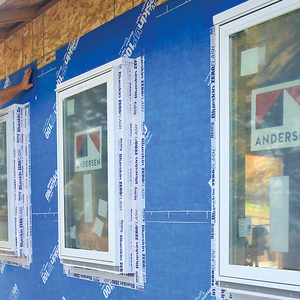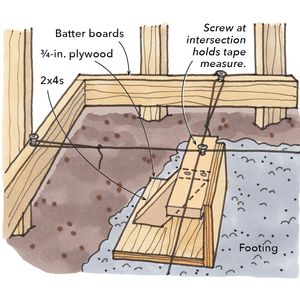Schluter says to use unmodified thinset. This magazine had a bit in the last issue where they used Kerdi and modified thinset. What’s the deal? Can I use damn near any thinset on the shelf? or what?
For good new rock music, click on:
http://www.myspace.com/rosehilldrive or
http://www.myspace.com/yearlongdisaster




















Replies
Are you referring to tile - kerdi
or kerdi - substrate?
I beleive they say unmodified for porcelain tile or other non-porous mat'l over the membrane since the modified needs air to cure and neither substrate is porous.
But IIRC, you should use modified to attach Kerdi to drywall.
Check out JohnBridgeTile or I know Schluter has a download of their install manual which covers most situations. Their customer service # is also helpful.
Unmodified thinset dries by chemical reaction, like setting-type gyprock compound. But modified air-dries, by evaporation of the water you mix into it.
Kerdi is completely impervious to moisture, and so is most tile. That said, you can see that if you trap a layer of modified thinset between a Kerdi membrane and a layer of tile, that thinset can take a very long time to dry properly (up to a month or more) because the only way out for the moisture is through the grout lines. (And if you grout the job, you slow down the drying process even more.)
Schluter specifies unmodified between the tile and any of their waterproof membranes. If you don't use it, you void the guarantee.
Dinosaur
How now, Mighty Sauron, that thou art not brought
low by this? For thine evil pales before that which
foolish men call Justice....
Thanks for that info! I didn't realize that setting type joint compoud cured differently. Are you talking about hot mud? Bob's next test date: 12/10/07
Slight thread digression here... hot mud and setting compound are the same thing. And yes, it cures different than regular mud. It hardens while still wet in a process called hydration.
Don answered you correctly, and taught me something I didn't know either. (I didn't know the term 'hot mud'. Must be wunna dose regional tings....)
You can get setting compound in various 'speeds'--90-minute; 45-minute; 30-minute; I've even heard of 10-minute setting compound but I've never seen it and can't imagine trying to work with it, LOL.
It's useful for when you've got a remod project small enough that you only spend an hour or two doing each coat of mud. Naturally, at the mud stage, there's not much else you can do until it's finished, so if you use regular joint compound on that, and even with lights and fans you wind up spending two hours a day for a week at a site and losing yer shirt. Use setting compound and you can safely put two or even three coats of mud down in one workday.
The downside is, setting compound is a cast-iron-bitch to sand compared to regular drying-type compound. Ferguson recommends using drying compound for the coat(s) you're gonna have to sand.
Dinosaur
How now, Mighty Sauron, that thou art not broughtlow by this? For thine evil pales before that whichfoolish men call Justice....
I always though modified thinset had polymer (read latex) added to basic thinset....and both dry like any mortar. Thought it was the premixed tile adhesive that air-dried....Digression, I recall reading recently that overhead tile was easier with the organic glues, due to high initial tack....
I always though modified thinset had polymer (read latex) added to basic thinset....and both dry like any mortar. Thought it was the premixed tile adhesive that air-dried....
In the 'good old days' (of about 15-20 years ago), all bagged thinset was the same, and you bought and added latex 'milk' to it instead of water if you wanted to modify it to be stickier (like adding hydrated lime to brick mortar to make it fatter, sort of).
All thinset mortar is a portland-cement-based product, so it dries the same way concrete does. But the addition of the latex changes the chemical reaction with the portland cement in the thinset. I'm no chemist so I can't tell you exactly how, but the result is that a thinset mortar mixed with polymer additives doesn't dry primarily by hydration reaction but by evaporation.
As to your other question, I'm not sure exactly what you mean by the name 'premixed tile adhesive', but if you're referring to a relatively new product labeled 'Premixed Thinset', well, that garbage is a completely bogus ploy by some particularly unscrupulous ho'es in somebody's marketing department.
'Premixed thinset' isn't thinset mortar at all, because it has no cement in it (it couldn't; you can't premix portland-based products with liquid because they will harden even inside a sealed container). If you examine the label carefully, you see it says 'premixed thinset adhesive' somewhere in small print--it does not say 'mortar'. That stuff is nothing more than a standard tile mastic with a bit of fine aggregate and some grey food-colouring thrown in to make it look like thinset mortar.
Bogus.
Dinosaur
How now, Mighty Sauron, that thou art not broughtlow by this? For thine evil pales before that whichfoolish men call Justice....
Mastic....yeah, that's the word!!!
Boy, either gettin' old really s**ks, or it's early onset Alzheimers.....Thanks for the erudite response-though I'm not sure how adding latex changes the chemistry from hydration to evaporation. I've been laying some pavers, and went looking into/for "Polysand" for the top sweep course...if you believe the chemists, the addition of polymers has made for bullet-proof concrete toppings, structural coatings, and all sorts of good stuff. Apparently the polymers come in organic & inorganic types....
The new 'hot' grouting compound for pavers up here is an epoxy-sand-stonedust mixture. I haven't used it myself yet. The literature on it says: sweep it in, wet it down, and walk away. Must be some kind of water-activated epoxy, although I can't quite figure how that might work. Whadda I know; I'm no chemist.
It is supposed to cure to a hard yet flexible grout that won't fracture and disintegrate after a couple of years like plain portland cement powder does used the same way. I would think you'd have to be pretty careful about getting all the dry grout off the surface of the pavers before you sprayed it, tho.
Dinosaur
How now, Mighty Sauron, that thou art not broughtlow by this? For thine evil pales before that whichfoolish men call Justice....
I used some type of powdered flexible grout on a stone landing that was activated by a sprinkling of water. I had my doubts but it worked well. It remained flexible like a rare steak. It went through two years before I moved and there was one spot that needed tweaking. Bob's next test date: 12/10/07
Have you see material labeled as being epoxy based.All I have seen say Polymerized Sand.http://www.packagepavement.com/joint_lock.htmlThe MSDS on this say 95-99% sand (quartz) and 1 - 5% Natural carbohydrate Material.And this one just says silca (dust) and the remainder non hazardous.http://www.supersandbond.com/.
.
A-holes. Hey every group has to have one. And I have been elected to be the one. I should make that my tagline.
Dinosaur, and all,Here is something I have wondered. Schluter says you can't use modified between Kerdi and large porcelain tiles, because it will not get hard until it dries, and it will take, say, a month to dry.Here is a thought experiment. Mix up some highly modified thinset mortar, then scoop it into an empty yogurt container, all the way full. Now put on the airtight lid. Will it cure? Yes or no?If yes, then Schluter is wrong.If no, then you have invented premixed thinset mortar.Which is it? Anyone?Bill
I am just guessing on this.But I suspect that after a few days you have have a glumply (technical turn)material that is not useable for anything.That it is still a cemment based product and that it will still start to hydrate. But the polymore part will still be liquid or goey..
.
A-holes. Hey every group has to have one. And I have been elected to be the one. I should make that my tagline.
Bill,That is also what I suspect. Glumply. Sort of a neither fish nor fowl kind of porridge. Yech.I think what happens with modified is that the Portland cement hydrates, but the suspended polymer stays wet in the millions of interstices, keeping the overall product semi-plastic. Once the mass dries out the polymer becomes insoluble in water, but the semi-cured thinset is not good for very much until the drying/curing job is finished.I made my post in part to demonstrate that things are not always black and white. Thinsets, for instance, are often a gray area ;-).Bill
It will cure...eventually. So no, you haven't invented premixed mortar.
But Schluter isn't wrong either, because they know almost no one is gonna lay tile and then wait a month or more before grouting it...and keep all traffic off it during that time. Their concern is that traffic on the tile during the hardening process will cause problems with adhesion, and they quite naturally want to avoid getting into warrantee pissing contests about whose fault that is: the installer, or the membrane itself.
In the real world, nothing is perfect. The first time I used the Kerdi membrane, I didn't read all the fine print (duh!) and since I had always used modified, I used modified on that job, too. I learned afterwards the what and the why of it all. Ooops.
But I got very lucky; that job has held up okay (almost certainly because the owners are very rarely there and the shower got virtually no traffic for the first six months after I completed it). Whatever; it was a damned good thing for me it did hold up, 'cause it's one of the most expensive installations I've ever done. If that one had failed, I'd still be washing dishes on the night shift at Dex's Diner to pay for it....
View Image
Dinosaur
How now, Mighty Sauron, that thou art not broughtlow by this? For thine evil pales before that whichfoolish men call Justice....
Dinosaur,I am glad to hear that you dodged the bullet on your first Kerdi job. John Bridge says in his e-book that lightly modified thinset works well for him, although it violates the warranty. Custom's Versabond is an example of the type.Bill
I've used Versabond, but I didn't realise it was a 'lite' version. One of these days I'm gonna have to learn to read, eh? ;o)
Dinosaur
How now, Mighty Sauron, that thou art not broughtlow by this? For thine evil pales before that whichfoolish men call Justice....
Why wouldn't the moisture just bleed out the back end? Does osb act like a moisture barrier now? Bob's next test date: 12/10/07
No OSB involved in the job I was talking about; that was in a basement. I built the shower from the concrete floor slab up (mud bed, Kerdi, tile).
But it's a legit question for the general case. If you use modified thinset below the membrane--that is to say, between it and a wood or wood-byproduct subfloor--the moisture will indeed percolate out through the subfloor, same as it would in a tile-on-wood or tile-on-CBU installation.
A lot of guys use modified under the membrane, and unmodified above it. I can't remember offhand whether Schluter okays that for their warranty, though.
Dinosaur
How now, Mighty Sauron, that thou art not broughtlow by this? For thine evil pales before that whichfoolish men call Justice....
Dear Dinosaur,
Thank you for the detailed response with the "why" it should be done. That is exactly what I needed and I will (already purchased) use unmodified.
Sincerely,
Larry the rooster
For good new rock music, click on:
http://www.myspace.com/rosehilldrive or
http://www.myspace.com/yearlongdisaster
You're more than welcome. I (like most people) prefer using modified whenever I can because it's physically easier (read, 'stickier') to work with. But when you understand why you shouldn't use it for specific applications, that makes it easier to take somehow....
Dinosaur
How now, Mighty Sauron, that thou art not broughtlow by this? For thine evil pales before that whichfoolish men call Justice....